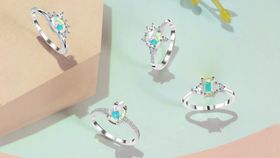Essential Ecommerce Branding Strategies
eCommerce branding is more essential than ever, so learn how to do it well, straight from one of the best people in the eCommerce field.
Published January 31, 2025.

Everyone loves good branding -- and in eCommerce, recent years have shown just what a powerful impact good branding can have. From the silly to the serious, there have been countless successful branding campaigns in recent years. And while it may seem like these marketing strategies come out of nowhere, the truth is that they’re often carefully crafted and executed by experts.
Take Glossier, for example, which has built a loyal customer base through minimalist design, user-generated content, and a strong focus on community. Warby Parker is another standout, known for its clean aesthetic, innovative try-at-home program, and socially conscious mission. And the list of examples can go on (and on.)
In 2025, eCommerce branding has grown to be more than just a "nice to have", though -- it's a must, especially considering the competitive landscape. So we asked one Igor Zvagelsky, one of our top-rated eCommerce SEO agency owners what is their take on this (and how they're helping their clients get there).
Here's what we learned:
Why your eCommerce needs branding in 2024
Branding is more important than ever for eCommerce businesses. As competition grows and customer expectations evolve, having a strong brand can set your business apart. Let's explore why eCommerce branding is essential in today’s competitive market.
Makes for a better customer experience
A strong brand creates a cohesive and memorable experience for your customers. From browsing your website to unboxing your products, every touchpoint should reflect your brand's identity. According to research, consistent branding can build trust with consumers and improve their overall experience. For example, when customers can easily recognize your brand values and aesthetic, they feel more confident purchasing from you.
Lowers your CAC (customer acquisition cost)
When your brand is well-known and trusted, attracting new customers becomes easier and cheaper. Instead of spending heavily on paid ads or promotions, a strong brand encourages word-of-mouth recommendations and organic engagement. Loyal customers are more likely to refer friends and family, further reducing your customer acquisition cost over time.
It’s a competitive advantage
In a saturated market, branding is how you stand out. Your products might be similar to those of your competitors, but your brand identity—your mission, values, and visuals—can make you unique. Customers are more likely to choose a brand they resonate with, even if other options exist.
It champions change
Modern consumers are increasingly choosing brands that align with their values. Strong branding gives you a platform to advocate for causes that matter to your audience, whether it’s sustainability, diversity, or innovation. By positioning your brand as a champion for change, you can attract customers who share your vision and want to support your mission.
How to build a branding strategy for your eCommerce business
Now that you understand why branding is essential, it’s time to develop a strategy that works for your eCommerce business. A thoughtful, consistent approach to branding can make all the difference in attracting and retaining customers.
Focus on your audience
Your audience should always be at the center of your branding strategy. Take the time to understand their needs, preferences, and pain points. Conduct surveys, analyze customer data, and create detailed buyer personas to guide your branding decisions. When you tailor your messaging and visuals to your audience, they’re more likely to connect with your brand.
Write down your brand mission and values
Your mission and values are the foundation of your brand. They define why your business exists and what it stands for. Write them down and make sure they’re communicated clearly across all touchpoints—from your website to your social media. A clear mission statement and strong values help build trust and loyalty with your audience.
Be authentic
Authenticity is key to building a brand that resonates. Consumers can tell when a brand is trying too hard or isn’t genuine. Stay true to your values and purpose, and don’t be afraid to show the human side of your business. Share your story, highlight behind-the-scenes moments, and engage with your audience authentically.
Invest in storytelling
Storytelling is one of the most powerful tools in branding. It helps create an emotional connection between your brand and your customers. Share stories about how your business started, the challenges you’ve overcome, and how your products make a difference in people's lives. Stories are memorable and can help you build a deeper connection with your audience.
Stay consistent across the board
Consistency is crucial when building a brand. Your voice, visuals, and messaging should be the same across all platforms, whether it’s your website, social media, or email marketing. This helps reinforce your brand identity and makes it easier for customers to recognize and trust you.
Make sure your brand guidelines are followed
Brand guidelines outline how your brand should be presented. They include rules for your logo, colors, fonts, tone of voice, and more. Ensure that everyone on your team and any third-party partners follow these guidelines to maintain a consistent and professional image.
Build and sell amazing products
Even the best branding can’t make up for poor-quality products. Your branding strategy should always be backed by great products that deliver on your promises. When customers are happy with what they buy, they’re more likely to return and recommend your brand to others.
Make your visuals pop
Your visuals are often the first thing customers notice about your brand. Invest in high-quality design for your website, packaging, and social media content. Use colors, fonts, and imagery that reflect your brand’s personality and values. Eye-catching visuals can make a lasting impression and encourage customers to engage with your brand.
eCommerce branding mistakes to avoid
When building your eCommerce brand, it’s important to avoid common pitfalls that can undermine your efforts.
One major mistake is inconsistent branding. If your messaging and visuals vary across platforms, it can confuse your audience and weaken your brand identity. Stick to your brand guidelines and ensure consistency in all your communications.
Another mistake is neglecting your audience. Failing to understand your customers’ needs and preferences can lead to branding that doesn’t resonate. Always keep your audience in mind when making branding decisions.
Lastly, don’t overlook the importance of quality. Poor-quality products or subpar customer service can damage your brand’s reputation, no matter how strong your branding is. Prioritize delivering value and exceeding customer expectations.
The best channels for eCommerce branding
Choosing the right channels to promote your brand is just as important as building your brand identity. Let’s explore some of the most effective channels for eCommerce branding.
Search engine optimization
Although it is frequently looked at from a performance marketing perspective, SEO is a powerful way to increase brand visibility. By optimizing your website for search engines, you can attract more organic traffic and position your brand as an authority in your industry. Focus on creating valuable, keyword-rich content that answers your audience’s questions and solves their problems.
Content marketing and video marketing
Content marketing helps you build trust and authority with your audience. Create blog posts, guides, and videos that provide value and showcase your expertise. Videos, in particular, are highly engaging and can help bring your brand to life. Consider creating product tutorials, behind-the-scenes videos, or customer testimonials to connect with your audience.
Social media marketing
Social media is one of the most effective tools for eCommerce branding. Platforms like Instagram, Facebook, and TikTok allow you to showcase your products, tell your brand story, and engage directly with your audience. Post regularly, use visually appealing content, and interact with your followers to build a strong social media presence.
Email marketing
Email marketing is a great way to nurture relationships with your customers. Use emails to share updates, promote new products, and provide exclusive offers. Personalize your emails to make them more relevant and engaging for your audience.
Packaging
Your packaging is an extension of your brand. High-quality, well-designed packaging can leave a lasting impression on your customers and make unboxing your products a memorable experience. Consider using eco-friendly materials and including touches like thank-you notes to show your appreciation.
Influencer marketing
Collaborating with influencers can help you reach new audiences and build trust with potential customers. Choose influencers whose values align with your brand and whose followers match your target audience. Authentic endorsements from influencers can boost your brand’s credibility and attract more customers.
(Source)
Small eCommerce challenges and how to overcome them
Running an eCommerce business comes with its own set of challenges, but with the right strategies, you can overcome them.
One common challenge is gaining customer trust. New eCommerce brands may struggle to convince customers to make a purchase. To build trust, focus on creating a professional website, showcasing customer reviews, and offering secure payment options.
Another challenge is standing out in a crowded market. With so many eCommerce brands competing for attention, differentiation is key. Invest in unique branding, emphasize your unique selling points, and create marketing campaigns that resonate with your target audience.
Finally, managing logistics can be tricky for small eCommerce businesses. From inventory management to shipping, inefficiencies can hurt your reputation and bottom line. Use technology to streamline operations, and partner with reliable logistics providers to ensure smooth and timely deliveries.
Conclusion
In 2024, branding is no longer optional for eCommerce businesses—it’s a necessity. A strong brand can enhance the customer experience, lower acquisition costs, and give you a competitive edge. By focusing on your audience, staying consistent, and using the right channels, you can build a brand that stands out and resonates with your customers.
...And if you need help, don't hesitate to reach out to Mayple. We will match you with the best eCommerce SEO agencies in your area and niche, manage the project for you, and ensure that your branding and marketing strategies are aligned with your business goals.




![Ecommerce Influencer Marketing Guide [{year}]](https://entail.mayple.com/en-assets/mayple/fit-in/280x280/61d2ea79f313c28f4c8db206_Influencermarketing_66db2fce7169ba4e06a08c2e7a96a606_2000-1699776073221.jpg)


